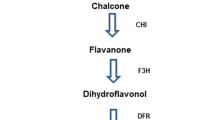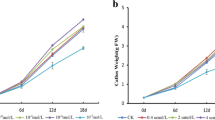Abstract
High anthocyanin-producing cell lines, which were grown in a dark or in a light-dark regime, were selected from callus cultures initiated from stem and leaf tissues of Aralia cordata Thunb. by small-cell-aggregate selection. To verify the optimum culture conditions for anthocyanin production, cells were tested by changing the various basal media, sucrose concentration and nitrogen source and concentration. Good growth was obtained in the dark on Linsmaier-Skoog's basal medium containing 1.0 mg l-1 2,4-d and 0.1 mg l-1 kinetin, 2% (w/v) sucrose and full strength of nitrogen concentration. However, the highest anthocyanin yield (10.3% dry wt) was obtained in the dark on B5 medium containing 1.0 mg l-1 2,4-d and 0.1 mg l-1 kinetin. Our results suggested that it has became feasible to find the most effective conditions for cell growth and anthocyanin production by optimizations of the nitrogen concentration and the ratio of NH4 + to NO3 - in the medium.
Similar content being viewed by others
Abbreviations
- B5:
-
Gamborg (Gamborg et al. 1968)
- 2,4-d :
-
2,4-dichlorophenoxyacetic acid
- LS:
-
Linsmaier and Skoog (Linsmaier & Skoog 1965)
- MS:
-
Murashige and Skoog (Murashige & Skoog 1962)
- NN:
-
Nitsch and Nitsch (Nitsch & Nitsch 1967)
- WH:
-
White (White 1963)
References
Callebaut A, Hendrickx G, Voets AM & Motte JC (1990) Anthocyanins in cell cultures of Ajuga reptans. Phytochemistry 29: 2153–2158
Carew DP & Krueger RJ (1976) Anthocyanidins of Catharanthus roseus callus cultures. Phytochemistry 15: 442
Dougall DK, Johnson JM & Whitten GH (1980) A clonal analysis of anthocyanin accumulation by cell cultures of wild carrot. Planta 149: 292–297
Gamborg OL, Miller RA & Ojima K (1968) Nutrient requirements of suspension cultures of soybean root cells. Exp. Cell. Res. 50: 151–158
Hiraoka N, Kodama T & Tomita Y (1986) Selection of Bupleurum falcatum callus line producing anthocyanins in darkness. J. Nat. Prod. 49: 470–474
Kakegawa K, Kaneko Y, Hattori E, Koike K & Takeda K (1987) Cell cultures of Centaurea cyanus produce malonated anthocyanin in uv light. Phytochemistry 26: 2261–2263
Kawai H, Nishida M, Tashiro Y, Kuroyanagi M, Ueno A & Satake M (1989) Studies on the structures of udosaponins A, B, C, D, E and F from Aralia cordata Thunb. Chem. Pharm. Bull. 37: 2318–2321
Kinnersley AM & Dougall DK (1980) Increase in anthocyanin yield from wild-carrot cell cultures by a selection system based on cell-aggregate size. Planta 149: 200–204
Linsmaier EM & Skoog F (1965) Organic growth factor requirements of tobacco tissue cultures. Physiol. Plant. 18: 100–127
Mihashi S, Yanagisawa I, Tanaka O & Shibata S (1969) Further study on the diterpenes of Aralia spp. Tetrahedron Lett. 21: 1683–1686
Mizukami H, Tomita K, Ohashi H & Hiraoka N (1988) Anthocyanin production in callus cultures of roselle (Hibiscus sabdariffa L.). Plant Cell Rep. 7: 553–556
Murashige T & Skoog F (1962) A revised medium for rapid growth and bioassays with tobacco tissue cultures. Physiol. Plant. 15: 473–497
Nitsch C & Nitsch JP (1967) The induction of flowering in vitro in stem segments of Plumbago indica L. I. The production of vegetative buds. Planta 72: 355–370
Nozue M, Kawai J & Yoshitama K (1987) Selection of a high anthocyanin-producing cell line of sweet potato cell cultures and identification of pigments. J. Plant Physiol. 129: 81–88
Rau D & Forkman G (1986) Anthocyanin synthesis in tissue cultures of Callistephus chinensis (China aster). Plant Cell Rep. 5: 435–438
Yamakawa T, Ishida K, Kato S, Kodama T & Minoda Y (1983) Formation and identification of anthocyanins in cultured cells of Vitis sp. Agric. Biol. Chem. 47: 997–1001
Yamamoto Y, Mizuguchi R & Yamada Y (1982) Selection of a high and stable pigmentproducing strain in cultured Euphorbia millii cells. Theor. Appl. Genet. 61: 113–116
Yamamoto Y, Kinoshita Y, Watanabe S & Yamada Y (1989) Anthocyanin production in suspension cultures of high-producing cells of Euphorbia millii. Agric. Biol. Chem. 53: 417–423
Yoshihara K & Hirose Y (1973) Terpenes from Aralia species. Phytochemistry 12: 468
White PR (Ed) (1963) The Cultivation of Animal and Plant Cells (p. 228). The Ronald Press, New York
Zhong J, Seki T, Kinoshita S & Yoshida T (1991) Effect of light irradiation on anthocyanin production by suspended culture of Perilla frutescens. Biotechnol. Bioeng. 38: 653–658
Author information
Authors and Affiliations
Additional information
This paper is part 81 in the series ‘Studies on Plant Tissue Cultures’. For Part 80 see Furuya T, Sakamoto K, Iida K, Asada Y, Yoshikawa T, Sakai S & Aimi N (1992) Phytochemistry 31: 3065–3068.
Rights and permissions
About this article
Cite this article
Sakamoto, K., Iida, K., Sawamura, K. et al. Anthocyanin production in cultured cells of Aralia cordata Thunb.. Plant Cell Tiss Organ Cult 36, 21–26 (1994). https://doi.org/10.1007/BF00048311
Received:
Accepted:
Issue Date:
DOI: https://doi.org/10.1007/BF00048311




